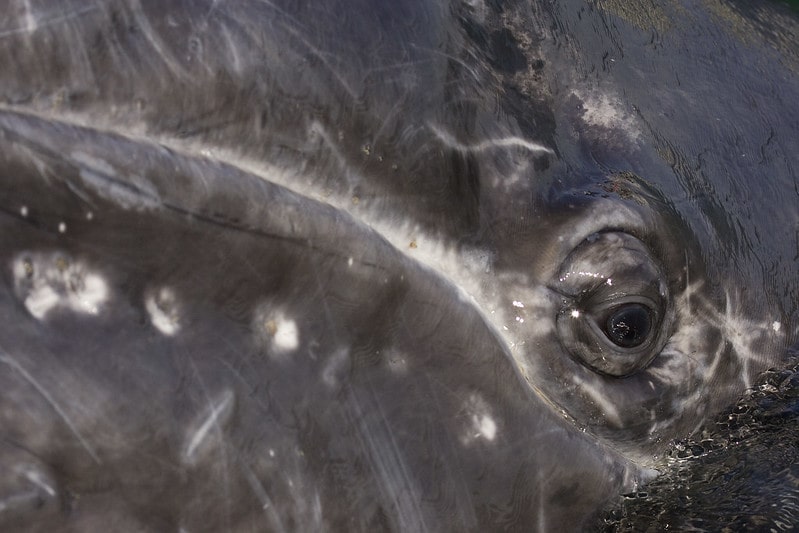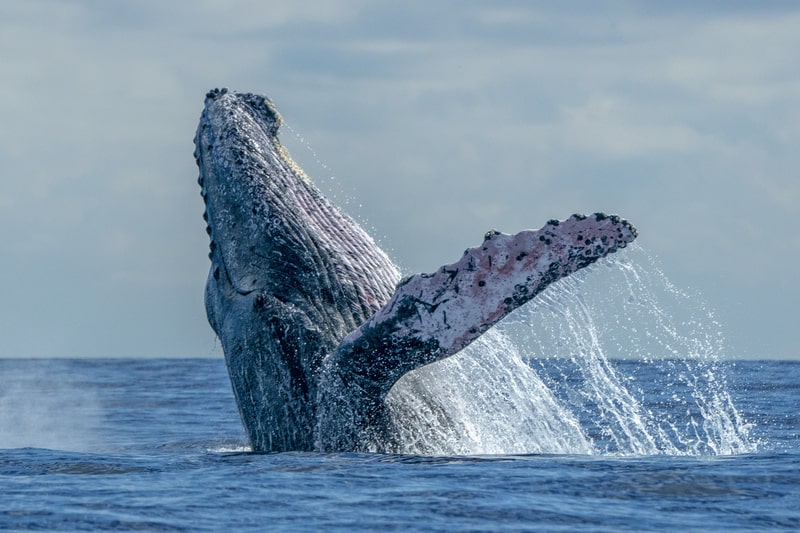Last updated on May 25th, 2023
56. Moby Dick
This classic novel revolves around a ship captain’s obsession with a white whale. The author, Herman Melville, was an experienced whaler who drew from actual events in the 1800s.
57. Baron Munchausen
Based on a real nobleman, this famous German fictional character had a tale about being swallowed by a whale — just like the biblical Jonah.
58. Whale Song Orchestra
Even humans can appreciate songs from the deep. “And God Created Whales” is an orchestral composition by Alan Hovhaness. It includes recorded sound from humpback whales and bowhead whales.
59. Whale Fishing
Whaling began in the Stone Age with humans using their meat for food, blubber for oil, bones for tools, and baleen for roofs. Later, these were also used to make fuel, lubricant, perfumes, corsets, and alternative medicines.
60. Conservation
In 1986, whale depletion pushed the International Whaling Commission to ban commercial whaling. Only indigenous people were allowed to hunt for survival. Meanwhile, the whale-watching industry grew, helping locals do business while promoting conservation.
1. Blue Whale facts

1. Blue whales give birth to giant 8-meter babies. These drink over 600L of milk and gain 90kg of weight each day.
2. Blue whales make literal long-distance calls all the time, with their sounds traveling more than 1000 miles using ultra-low frequency waves.
3. We typically think of blood vessels as narrow pathways, but blue whales are so huge that a human infant could crawl through their coronary arteries.
4. Scientists tag blue whales with satellite trackers to see their migration routes, protect their feeding grounds, and prevent entanglements with fishing vessels.
5. Despite their name, blue whales are not purely blue. They might look like it underwater, but the top of their body is a mottled gray. Meanwhile, their belly is yellowish-white because of microorganisms.
2. Fin Whale facts

1. Fin whales are the second largest whales. It gets its name from an easy-to-spot fin on its back, near its tail. They can live for up to 90 years and grows to almost 90 feet long. Females tend to be 5-10% bigger than males.
2. Fin whales aren’t fond of big crowds. They usually spend their time alone, away from family, though they might travel with small groups for short periods.
3. Fin whales roam oceans around the world, except for the polar regions. Their massive size makes it difficult to find cracks in the ice big enough to breathe on the surface.
4. Some people call fin whales the “razorbacks” because of the shape of their back and their small pointed dorsal fin.
5. Fin whales have asymmetric face coloring. It’s gray on the left and yellowish-white on the right. They like to intimidate schools of fish with the brighter colors.
3. Gray Whale facts

1. Gray whales are feisty sea giants. They won’t go down without a fight, such as when whalers attack with harpoons. This earned them the nickname “devil fish”.
2. Despite their fearsome reputation, gray whales have their own charming features, such as having two blowholes that expel air and water in a heart-shaped pattern.
3. In Mexico’s Baja Peninsula, gray whales have gotten friendly with locals. They even approach whale-watching boats for petting by ecstatic humans.
4. Before they approach, they do a series of “spyhops”. The whales slowly raise their head above water while holding a vertical position — just to get a closer look.
5. The maternal instinct is strong among gray whales. If they sense danger from predators, then they might swim upside down with their baby on their belly to protect it.
4. Narwhal facts

1. The word “narwhal” is an Old Norse term that means “corpse whale”. It comes from early observations that they like to swim belly up and motionless for a long time. If sailors approach, they suddenly spring to life and swim away.
2. Narwhal tusks have holes that let water in. Their 10 million nerve endings can detect changes in the water’s temperature.
3. Narwhals are slim enough to fit inside ice cracks, allowing them to breathe while staying in Arctic waters. However, they need to watch out for predators like polar bears and walruses.
4. Food is life for narwhals. These great divers can reach depths of up to 1,600m and hold their breath for 25 minutes. With compressible rib cages, they can shrug off intense water pressure just to eat.
5. Narwhals change color as they grow older. They are born as blue-gray babies, turn into blue-black adults, and develop mostly white skin in old age.
5. Humpback Whale facts

1. Its scientific name “Megaptera novaeangliae” means “giant wing of New England” – a reference to its 16ft long front fins and frequent sightings along the New England coast.
2. Humpback whales often breach the water’s surface. They leap up high, then make a spectacular splash landing. Scientists aren’t quite sure if they are just playing or trying get rid of pests on their skin.
3. Humpback heads are covered with knobs called tubercles. Each of these have at least one stiff hair — possibly functioning as a natural motion detector.
4. Every humpback whale has a uniquely shaped fluke and dorsal fin. These also have distinct color patterns, allowing scientists to identify and monitor them for years.
5. Humpbacks are experienced world travelers. Most of them move from the Gulf of Alaska to the equatorial waters during winter, except for humpbacks that live all year in the Arabian Sea.
6. Orca Whale facts

1. Orcas are formidable apex predators. Ancient sailors called them “asesina ballenas” or killer whales after seeing them feast on larger whales.
2. Despite their popular and terrifying name, orcas are not whales. They are actually the largest member of the dolphin family.
3. Orcas are extremely intelligent. They have the second largest brain of any animal. In the wild, they can coordinate hunting tactics to bring down massive targets. In captivity, they can perform tricks and put on a show.
4. Aside from humans, orcas are the only other animal to evolve based on culture. They have branched off to different groups, each having their own language, entertainment, hunting tactics, mating criteria, food choice, and special behaviors.
5. Only three animal species experience menopause: humans, short-finned pilot whales, and orcas. It helps avoid fights over limited resources and shifts focus on raising families.
7. Sperm Whale facts

1. Sperm whales are named after the spermaceti organ on their heads. It contains up to 1,900L of oil, enabling the creatures to float with ease and helping them hear better.
2. Early Spanish sailors called these whales “cachalot” which means “big head”.
3. Sperm whales can hold their breath for more than 2hrs, allowing them to dive deeper than 3,000m. It’s enough to make them the third deepest-diving mammal.
4. Scientists can identify sperm whale blows even from far away. After all, their blows can reach up to 16ft high, with a distinct lean to the left due to their uneven skull.
5. According to DNA analysis, all the living sperm whales today are descendants of a single female — their great great grandmother — which lived 10,000 to 80,000 years ago.
8. Sei Whale facts

1. Fishermen in Norway noticed that whenever this whale was around, pollack fish are probably nearby. Sei is the Norwegian word for pollack, hence the name. In some places, they are called sardine whales or coalfish whales for the same reason.
2. Sei whales have a unique ridge that starts from the tip of the snout and end at the two blowholes above the head.
3. Sei whales have a streamlined body that lets them swim up to 34mph for extended periods, and 50mph for short sprints. However, they get tired quickly like cheetahs.
4. There are two subspecies: the northern and southern sei whales. They are biological similar but don’t interact. Curiously, they could mate with fin whales and have babies.
5. Sei whales are known for leaving “fluke prints”. These are smooth circles on the water’s surface made by their fluke movement, making it easy to find their location.
9. Beluga whale facts

1. Beluga whales get lighter as they get older. As babies, they have dark gray skin. It takes 5 to 8 years for them to achieve their all-white complexion. Their name comes from the Russian word for white which is “bielo”.
2. Belugas are called the canaries of the sea because of the wide range of sounds that they can make. They can whistle, chirp, moo, click, and squeal. They can even mimic human speech and trick their keepers.
3. Unlike other whales, belugas have a flexible neck that lets them move their head independently. They can nod and turn in all directions. They can also swim backwards.
4. Belugas are highly social and communicative. They can make facial expressions like humans, so they have more options when conveying their messages.
5. In 2009, a beluga whale saved a drowning diver in China. She is an experienced diver who cramped up in the middle of a test. The whale pushed her to the surface for safety.
10. Bryde’s Whale facts

1. You can spot Bryde’s whale based on its three long ridges on the head. The name comes from the Norwegian consul to South Africa, Johan Bryde, who helped build the country’s first modern whaling station. It is pronounced as “brooders whale”.
2. In Japan, they call it the anchovy (iwashi) whale or the skipjack (katsuo-kujira) whale because it preys on these fishes.
3. Bryde’s whale is a tropical whale that prefers warm waters, typically 16 degrees Celsius and up. It is the only baleen whale to exhibit this behavior.
4. Bryde’s whale is an ideal attraction for whale watchers. It doesn’t dive too deep, and mostly stays within 10 meters of the surface — providing ample chances for viewing.
5. After genetic testing, the Bryde’s whale found in the Gulf of Mexico is now classified as a separate species called Rice’s whale — a tribute to the scientist, Dale Rice, who discovered it in 1965.
11. North Pacific Right Whale facts

1. The North Pacific right whale can grow up to 60ft long and weigh as much as 100 tons as an adult. It is larger than both the gray whales and the humpbacks.
2. It has a stout body with a girth roughly 73% of its length. This probably contributes to its slow swimming speed, making it vulnerable to hunters.
3. Before it was heavily exploited, this right whale could be seen around the Gulf of Alaska and Sea of Japan. Now most sightings are around the Bering Sea and the Eastern Aleutian Islands.
4. These right whales have a curved mouth that’s always open to feed on the ocean’s bounty. After all, it needs a lot of food to maintain its size.
5. Alaska researchers have photographed a right whale pushing a log as it swims, probably just playing with it like a toy.
12. North Atlantic Right Whale facts
1. Its scientific name is Eubalaena glacialis, which means “good whale of ice”. These are gentle giants of the sea growing up to 55ft long and weighing up to 70 tons.
2. Right whales are the only whales with callosities, raised white patches of rough skin on the head. Every individual has unique pattern. Scientists believe that they are caused by parasites called cyamids or whale lice.
3. Since they live on cold waters, they need a lot of fat for insulation. About 40% of a right whale’s body weight is blubber for temperature regulation.
4. Scientists use 13 detection buoys to listen to right whales around Massachusetts Bay. Once detected, they signal ships to slow down to prevent collisions or entanglements.
5. Right whales help us breathe. They produce waste called plumes that fertilize the oceans and feed phytoplankton which, in turn, produces 50% of the world’s oxygen.
